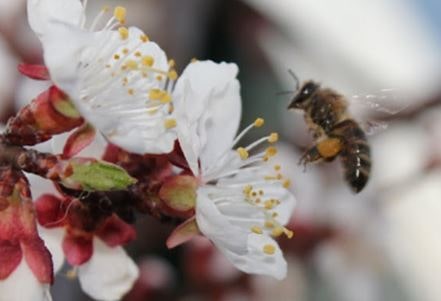Apricot as a honey plant, honey productivity and pollination in the garden

Photo of a bee on an apricot flower
The valuable fruit crop apricot is important for bees as a honey plant and pollen plant, allowing bees to develop colonies in the spring after wintering. Among the stone fruit crops (apricot, peach, cherry, sweet cherry, plum, cherry plum), apricot occupies vast areas in Central Asia (Turkmenistan, Kyrgyzstan, Kazakhstan, Uzbekistan, Tajikistan), the Caucasus (Georgia, Armenia and Azerbaijan), the southern regions of Russia, Ukraine , Moldova, the Balkans and Southern Europe. In turn, apricot is very responsive to pollination by bees.
Content
- Description of the honey plant apricot
- Types of honey plant apricot
- Apricot pollination by bees
- Common apricot as a honey plant
- What is the honey productivity of apricot?
- The benefits of apricot for bees
- Siberian apricot honey plant
- Manchurian apricot honey plant
Description of the honey plant apricot
Honey plant apricot Latin name Armeniaca vulgaris L. fruit tree - an excellent early honey plant - a genus of deciduous trees, less often shrubs of the rose family.
The height of apricot trees reaches 17 m.
Apricot leaves are elongated oval to heart-shaped, on long petioles.
Apricot flowers are white or pink, large, single or several in bunches. There are many stamens.
Types of honey plant apricot
The common or cultivated apricot grows in the mountains of Central Asia. It is cultivated in Central Asia, Crimea, the Caucasus, southern Ukraine and Moldova. Tree 5-8 m high, with a round or flat crown. The leaves are pointed, serrated, dark green above, matte below, sometimes pubescent along the edges and along the veins.
Apricot flowers are whitish-red, almost sessile.
Apricot pollination by bees
Many nuances of apricot pollination in gardens are discussed in detail in the book How to carry out paid pollination of gardens and crops with honey bees.
Features of pollination of apricot and peach by honey bees
In general, pollination of apricots by bees leads to an increase in yield by up to 25%.
[Text is available only for registered users]
Apricot as a honey plant
Apricot honey plant is an important plant for bees, which allows bees to collect a lot of fresh pollen and nectar in early spring for the spring development of families. The apricot honey plant blooms in March-April, the duration of apricot flowering is 12-15 days.
What is the honey productivity of apricot?
How much honey can bees collect from an apricot? The apricot honey plant produces the earliest honey harvest and is well visited by bees. The honey productivity of apricot reaches 40 kg per 1 ha.
The benefits of apricot for bees
The apricot honey plant is also important for bees as a source of pollen. In spring, bees collect a lot of yellowish pollen from apricot trees. On a sunny day, bees carry a lot of yellow apricot pollen. This is important for colonies that develop after wintering by raising young bees.
Siberian apricot honey plant
In Transbaikalia and the Primorsky Territory there is a wild growing honey plant, Siberian apricot - a shrub up to 3 m high.
Siberian apricot blooms in April-May, about 14 days.
Apricot, as a honey plant, is readily visited by bees. The honey productivity of Siberian apricot is 35-40 kg per 1 ha.
Manchurian apricot honey plant
Apricot Manchurian honey plant is a tree 5-15 m high. It grows in the south of Primorsky Krai on dry rocky slopes, singly or in small groups. Manchurian apricot blooms in the 1st half of May, 10-12 days.
Like a honey plant apricot Manchurian is an interesting plant. On the one hand, apricot flowers release nectar abundantly, but due to the sparseness of plantings, this type of apricot does not play a noticeable role in honey collection.
